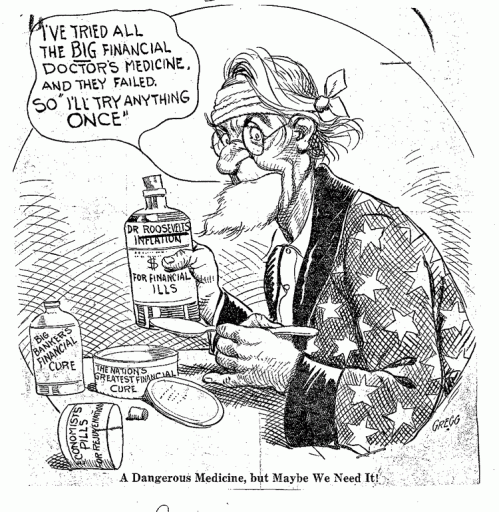Robert Higgs noted here on July 6th that FDR defaulted on the national debt by “going off the gold standard.” Moreover, FDR was (and is) much praised for his courageous action in favor of the “little guy” and against “sound money” bankers. FDR did this with a stroke of the pen (Executive Order) and by later asking Congress to confirm that he had the power to devalue the debt by 41%. Even critics conceded that FDR had balls; they only questioned whether he had “brains.” (H.L. Mencken blasted New Deal measures that came at the expense of those who worked and saved: “Every American who helped to earn and amass what is left of the wealth of this country is worse off now . . . .” “As for the risk [New Dealers] take, they have nothing to lose but their ‘brains.’”)
“Going off the gold standard” thus constituted a massive write-down of debt for the government, with the promise of an “inflation cure” to get “idle money” circulating again. Could our government do something so radical again? With the national debt nearing $15 trillion, we have witnessed unprecedented measures by the Federal Reserve to print money. We only wait for some wit to coin the term “a trillion here, a trillion there and pretty soon you are talking real money.” The Fed has done its part to devalue the currency, create economic uncertainty, and feed our growing government appetite for debt.
But back to the lessons of the New Deal. Consider an even more radical measure modeled after FDR’s actions: President Barack Obama follows FDR’s example by invoking World War I-era legislation (as amended) to exchange old dollars for new “Obama Dollars.” (In the 1930s, pundits referred to the new Federal Reserve notes as “Roosevelt Dollars”). FDR relied on the “Trading with the Enemy Act” (1917, amended 1933) which is still in force and “gives the President the power to oversee or restrict any and all trade between the U.S. and its enemies in times of war.” FDR wasn’t at war in 1933 but he likened the depression to a war. Crafty devil.
President Obama would not have to seize all gold, as FDR did, because our paper money (or its electronic equivalent) is no longer backed by gold. But countries have lowered their debt by exchanging new notes for old and rendering the latter unacceptable for exchange. Back in 1933-1934, FDR and Congress went even further: “anti-hoarding” legislation make it illegal to hold gold. “Hoarders” could get a hefty fine and imprisonment up to 10 years! If you think this is unthinkable, consider a) it’s been done before and b) financial commentators were floating this idea even before the meltdown of late 2008! Most cautioned, however, that history didn’t offer much support for the “devalue-your-debt” path to prosperity.
In 1933-1934, FDR declared that our “government of the people” meant that the government had an “inherent right” to monopolize money and “the people” had no such right–indeed, they became criminals if they possessed gold. The government still claims the “inherent right” to monopolize money despite allowing us to once again own gold and silver (a “privilege” bestowed to us in the 1970s). But the power to devalue, either with a pen stroke or more QE, remains. My next post (Part II) offers a quick cartoon guide to how FDR devalued the debt between April 1933 and January 1934. Let’s hope Barack Obama isn’t reading.
(continued here)
***
Further reading:
See the essential Robert Higgs, Depression, War and Cold War (Oxford, 2009)
Barry Eichengreen’s Golden Fetters (1996) blames the gold standard for the depression and extols the benefits of devaluation.
